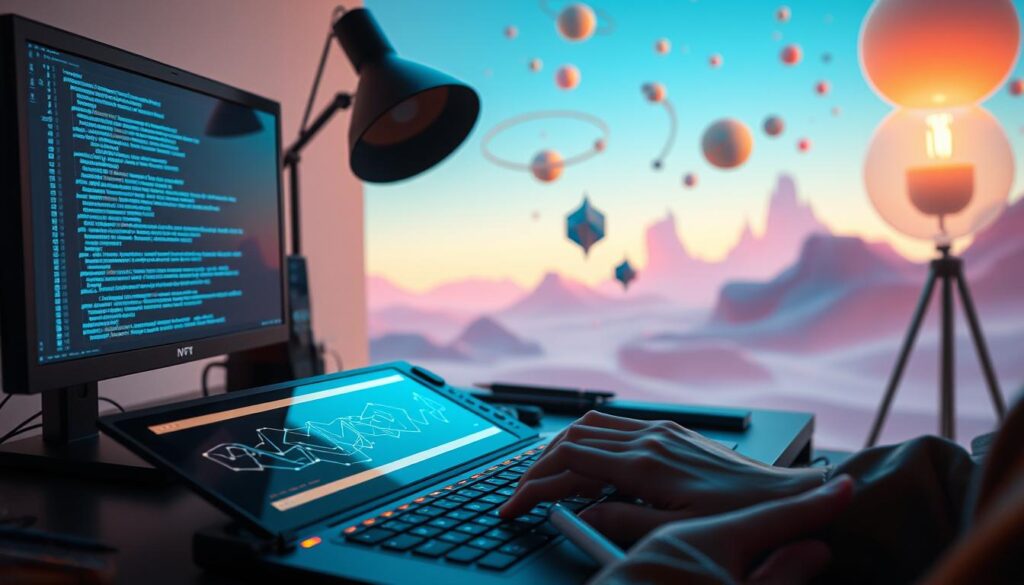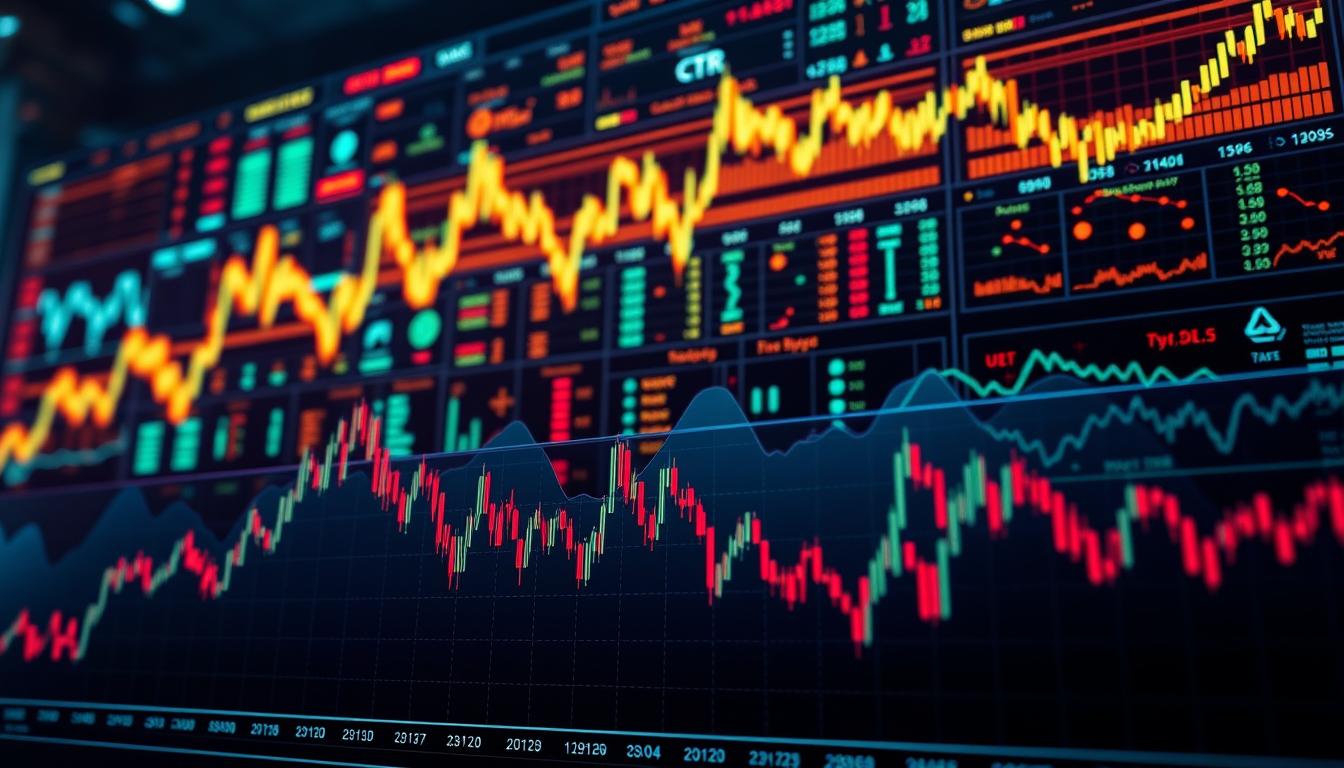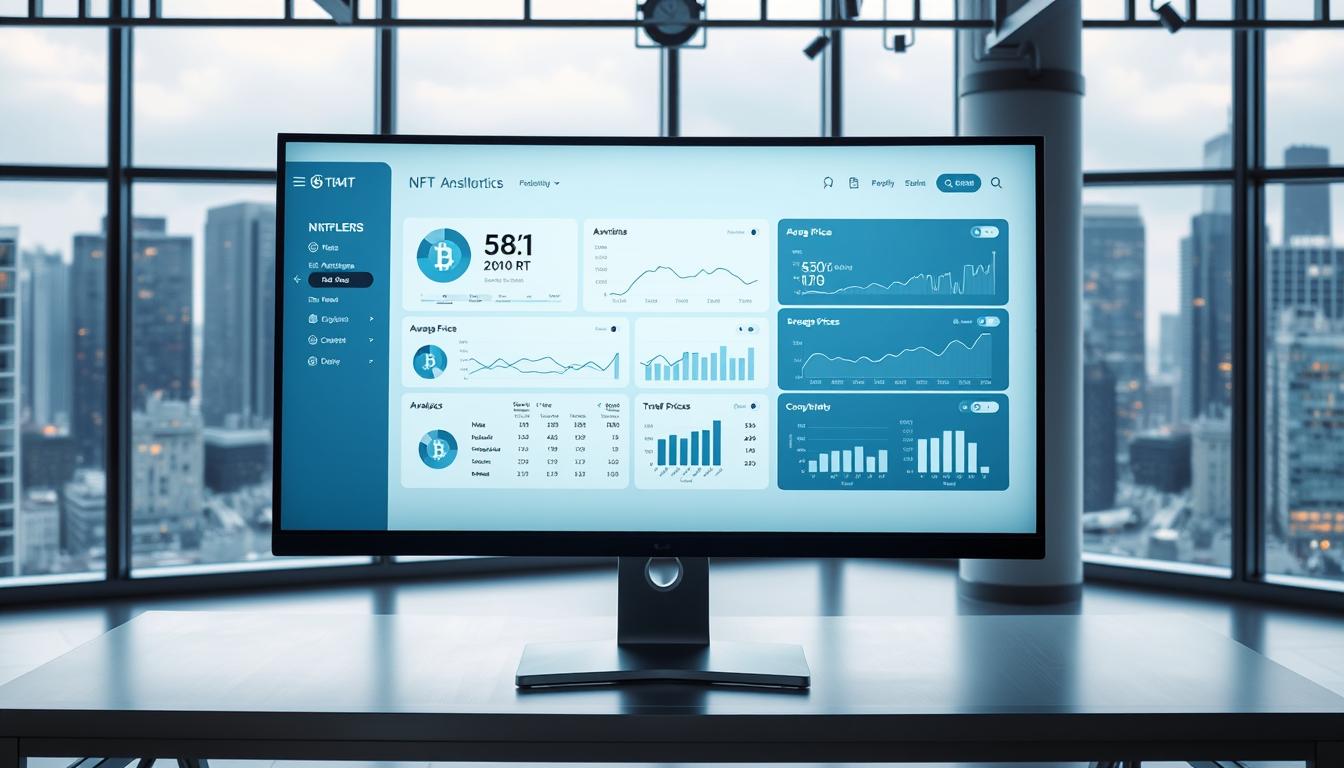Now Reading: Free NFT Generator Tools for Digital Artists: Create Unique Art
- 01
Free NFT Generator Tools for Digital Artists: Create Unique Art
Free NFT Generator Tools for Digital Artists: Create Unique Art
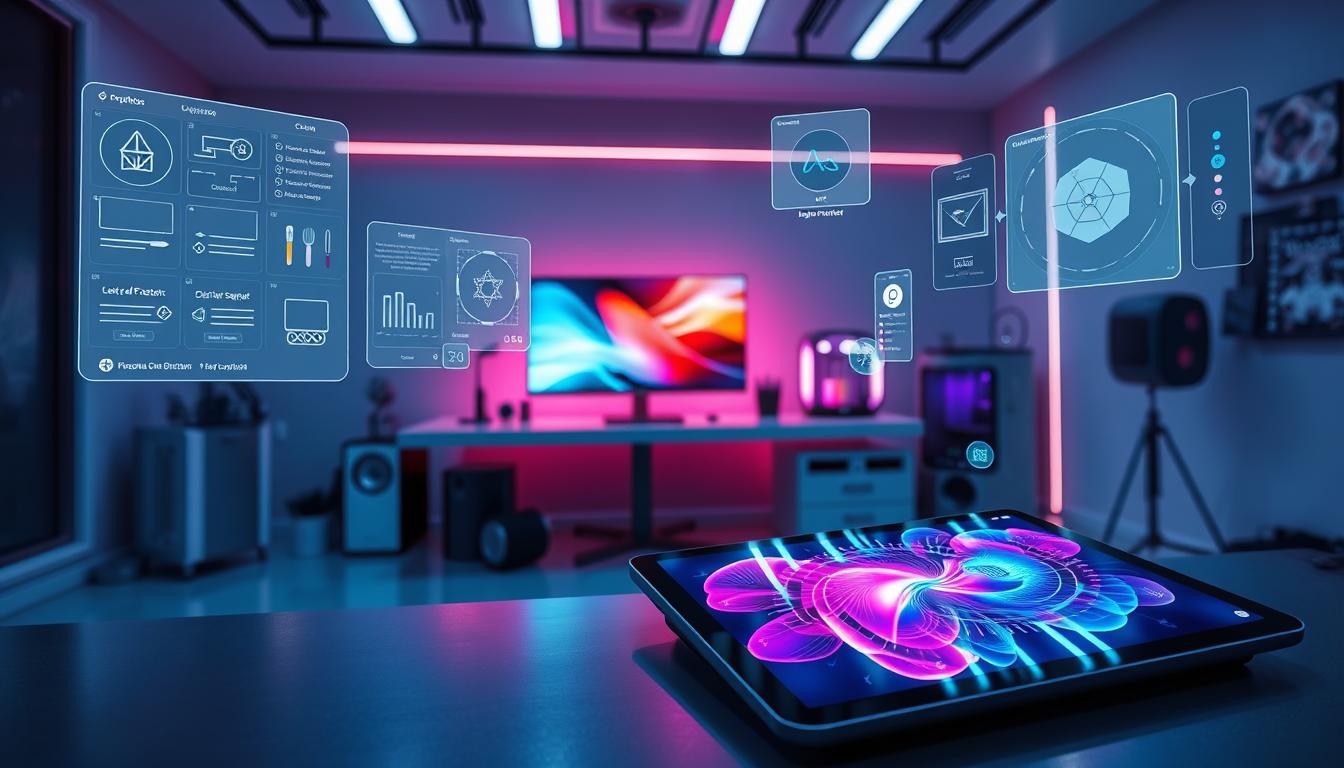
The creative world is changing fast. New technology lets artists turn their work into something special on the blockchain. This shift helps creators show ownership and connect with fans in fresh ways.
Accessible platforms now let anyone make blockchain-based art, even without coding skills. These solutions remove expensive barriers, letting creators focus on their vision instead of technical hurdles. Over 60% of emerging artists report using no-cost options to start selling their work online.
Markets for digital collectibles keep growing, offering global exposure and new income streams. Modern interfaces simplify complex steps like minting or adding metadata. This lets photographers, designers, and illustrators join the movement without big investments.
Key Takeaways
- Blockchain technology enables verifiable ownership for digital artwork
- User-friendly platforms require no coding experience to start creating
- Global marketplaces connect artists with international collectors
- Metadata customization helps artworks stand out in crowded spaces
- Low-cost entry points support emerging talent across creative fields
Exploring the NFT Landscape for Digital Artists
The way creators protect and profit from their work is undergoing a seismic shift. Unique identifiers on blockchain networks now let artists prove authenticity while maintaining control over their intellectual property. This system transforms how value is assigned to creative content in the digital age.
![]()
Understanding NFTs and Digital Ownership
Non-fungible tokens act as digital certificates for original creations. Each token contains metadata that verifies scarcity and tracks provenance. Artists can embed royalty clauses into smart contracts, ensuring automatic payments when collectors resell pieces.
This model contrasts with traditional art markets where creators rarely benefit from secondary sales. Over 75% of blockchain-based transactions now include royalty features. The system empowers makers to earn recurring income from their work.
The Role of Blockchain in Art Creation
Distributed ledger technology provides an unchangeable record of ownership history. Popular networks like Ethereum and Solana offer different benefits for minting:
| Network | Transaction Cost | Energy Use | Royalty Support |
|---|---|---|---|
| Ethereum | High | Moderate | Full |
| Solana | Low | Low | Partial |
| Polygon | Very Low | Very Low | Full |
Choosing the right platform affects profitability and environmental impact. Many creators prioritize networks with lower fees and transparent energy policies. The decentralized nature of these systems removes gatekeepers, letting artists connect directly with global audiences.
Features and Benefits of Free NFT Generator Tools
Empowering artists with intuitive platforms transforms how digital art is created and shared. Modern solutions combine professional-grade capabilities with approachable interfaces, removing technical barriers that once limited creative expression. Over 80% of creators using these systems report faster project completion times compared to manual coding methods.
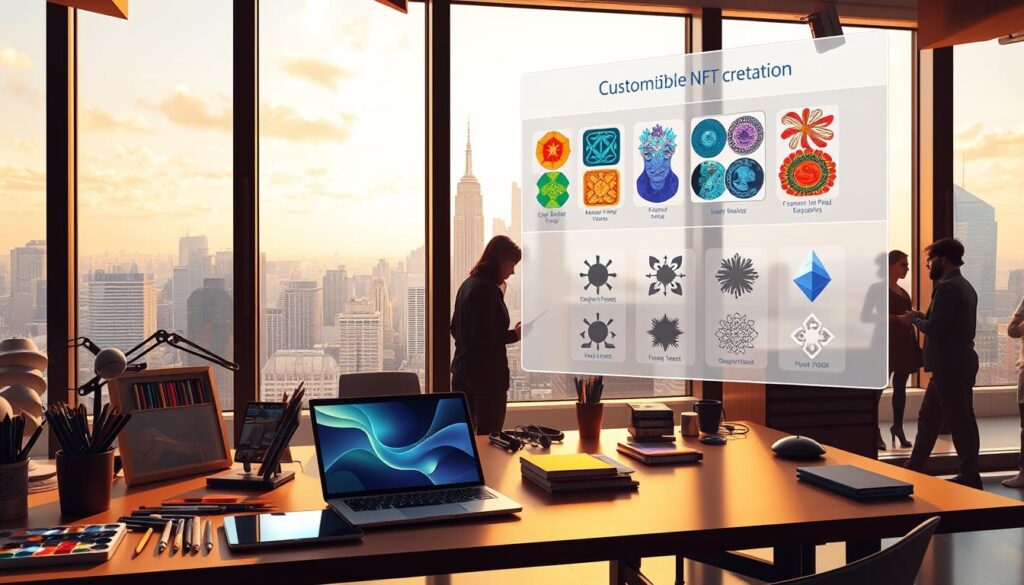
Ease of Use and No Coding Requirements
Drag-and-drop builders make blockchain art development accessible to everyone. These interfaces mirror familiar design software layouts, letting users focus on artistic vision rather than technical details. Real-time previews show exactly how pieces will appear across devices and marketplaces.
Pre-built templates help newcomers start projects quickly while maintaining originality. Advanced editors handle complex tasks like layer management and metadata integration automatically. This streamlined approach enables creators to produce gallery-ready works in minutes instead of hours.
Customization and Creative Flexibility
Platforms offer both structured templates and blank canvases to suit different workflows. Color palettes, texture libraries, and animation tools let artists develop distinct visual styles. Built-in editors support everything from simple icon design to multi-frame animated sequences.
Specialized features include:
- Cross-format export options for images, GIFs, and 3D files
- Smart layering systems that preserve editing flexibility
- Royalty percentage calculators integrated into minting workflows
Artists can explore various techniques through these systems while maintaining full ownership rights. Many platforms provide comprehensive guides to NFT creation platforms, helping creators maximize their toolkit’s potential. This combination of power and simplicity helps artists turn concepts into collectibles without compromising their unique style.
free NFT generator tools for digital artists: A Detailed Look
The journey from concept to collectible has never been more accessible. Modern platforms combine artistic tools with blockchain integration, creating seamless workflows for visual creators. These systems handle technical complexities while preserving creative control.
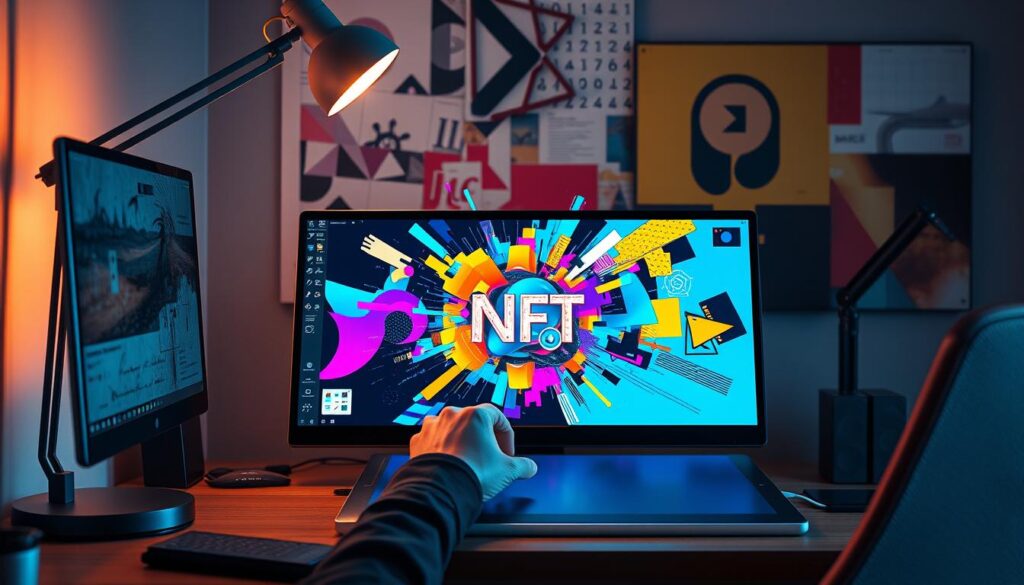
Essential Features for Modern Creators
Leading solutions like Mediamodifier provide integrated environments for design, minting, and distribution. Users connect cryptocurrency wallets to activate full functionality, bypassing coding requirements. Built-in editors support multi-layer compositions and animation timelines.
From Studio to Marketplace
Automated processes transform finished pieces into blockchain assets. The system handles metadata embedding and network fees, using Polygon for low-cost transactions. Completed works appear instantly on OpenSea under customizable privacy settings.
| Stage | Action | Benefit |
|---|---|---|
| Design | Combine media assets | Royalty calculator integration |
| Mint | Gas-free processing | Instant marketplace upload |
| Sell | Set pricing strategy | 2.5% success fee only |
Balancing Guidance and Originality
Template libraries help overcome creative blocks while maintaining unique outputs. Artists can modify pre-built layouts or start from blank canvases. Advanced users incorporate vector graphics and GIFs for dynamic results.
This approach lets creators focus on storytelling through visual media. The hidden listing feature allows strategic release planning, while ownership remains fully with the artist.
How to Choose the Right NFT Maker for Your Needs
Selecting the optimal platform requires matching your creative process with technical capabilities. Most solutions fall into two groups: those specializing in artwork development and full-service ecosystems with built-in sales channels. Your choice depends on workflow needs and long-term business objectives.

Assessing User Requirements and Design Capabilities
Begin by analyzing your technical comfort level. Some art generator platforms offer drag-and-drop simplicity, while others require file format expertise. Check template libraries and editing tools against your existing brand style or project vision.
File compatibility matters when transferring assets between software. Look for services supporting PNG, SVG, and MP4 formats if creating animated pieces. Advanced makers provide layer management systems for complex compositions.
Comparing Marketplace Features and Monetization Options
Integrated sales channels streamline launching collections. Platforms with direct marketplace connections let you publish works instantly to major hubs. Others require manual uploads, adding steps between creation and sales.
Examine fee structures carefully. Some services take 5-15% commission per sale, while others charge flat listing fees. Premium tiers often unlock better marketing tools like social media integrations or featured collection spots.
For creators exploring AI-enhanced workflows, select platforms offering smart minting features. These systems automate metadata tagging while preserving artistic control, helping you sell NFT assets more effectively.
User Experiences and Success Stories in the NFT World
Creative professionals worldwide are reshaping artistic careers through blockchain technology. Their journeys reveal how intuitive platforms bridge imagination and marketplace success. Three key themes emerge: accessibility, adaptability, and community-driven growth.
Real-Life Testimonials from Digital Artists
TraceTheDream1313 describes their creative routine: “This app became part of my morning ritual – brainstorming prompts while sipping coffee.” Many users report similar integration into daily workflows, turning sporadic ideas into consistent output.
Long-term creators like Vegastowerssucks emphasize foundational value: “This platform launched my entire career. Its stability made complex processes feel approachable.” Such feedback highlights how reliable services lower entry barriers for newcomers.
Insights from Popular NFT Platforms
Mobile accessibility drives global participation. ɘlbe spurling notes: “I create on-the-go using my phone when away from desktop setups.” This portability lets artists maintain momentum across locations.
Key platform differentiators include:
- 24/7 access through web and mobile interfaces
- Real-time collaboration features for remote teams
- Automatic metadata optimization for better collection visibility
Community reviews shape platform evolution. Developers now prioritize features requested by active users, creating ecosystems that adapt to creator needs. This responsiveness helps artists from all backgrounds turn visions into viable creations.
Final Thoughts on Embracing the NFT Future for Digital Artists
Visual storytelling enters a transformative era with blockchain verification reshaping creative careers. From individual makers to global brands, this movement offers ownership solutions that bridge physical and virtual worlds. Early adopters gain strategic advantages in building loyal collector bases before markets mature.
The Metaverse connection amplifies value for digital creations, turning artworks into cross-platform assets. Modern solutions let artists convert existing portfolios into verifiable tokens without complex processes. This preserves copyright control while opening revenue streams beyond traditional galleries.
New marketing frontiers emerge through direct engagement with crypto-savvy audiences. Platforms like Mediamodifier simplify design workflows, letting creators focus on unique styles rather than technical hurdles. Built-in royalty systems ensure ongoing compensation as works change hands.
Success in this space requires balancing artistic vision with community trends. While the ecosystem thrives on innovation, authenticity remains key to standing out. As virtual economies expand, accessible tools empower talent at all levels to turn passion into sustainable careers.


